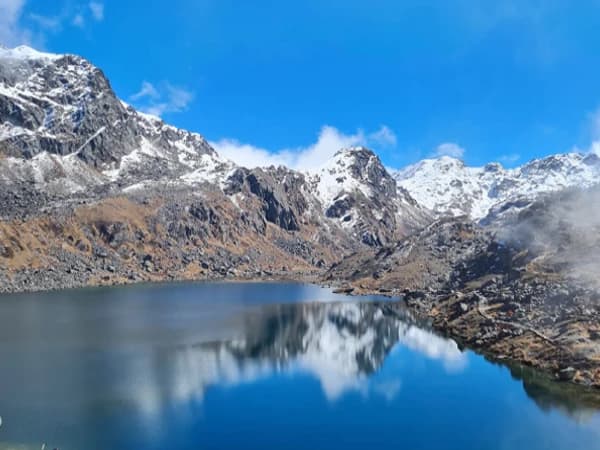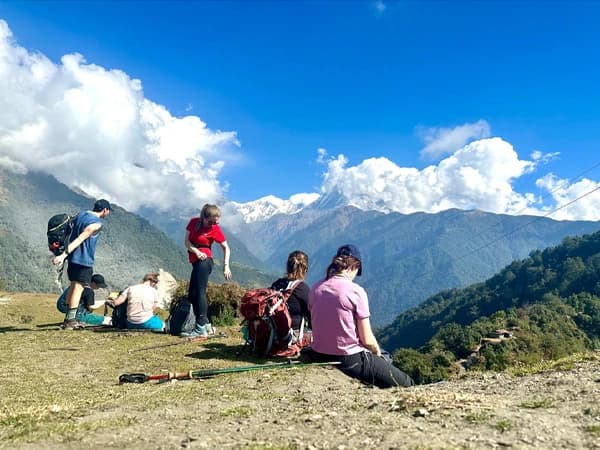Overview of Thorong La Pass Annapurna Circuit Trekking in Nepal
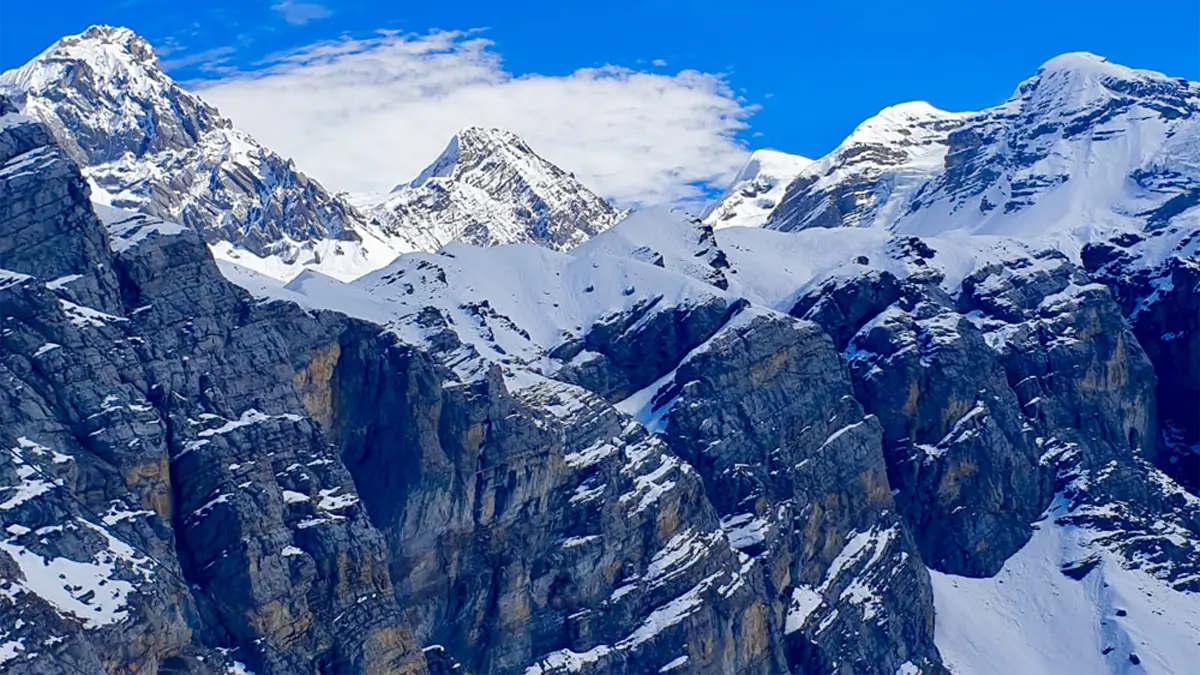
Thorough La Pass is situated in the Annapurna region and reaches 5,416 meters above sea level. This pass is one of the highest trekking passes. It is situated in the designated Annapurna Conservation Area and divides the Manang and Mustang districts.
Moreover, it is an essential historical trade pass linking Tibet’s Plateau and the lowlands of Nepal. Manang Valley also illustrates the Buddhist life in the region with the sight of new monasteries, mani walls, and prayer flags.
On your way throughout the Manang Valley, you might see the local influence of Buddhism in the area – new monasteries, mani walls, and prayer flags around. Still, in the neighbouring Mustang region, most of the culture is Buddsium – ancient villages, quiet valleys, and sacred places.
Plus, the view – it is everything you picture it out to be. At the top of the pass, you can observe many himalayas peak and the hills in the Annapurna region.
Thorong Phedi or High Camp: Where to Stay Before Thorong La Pass
In case you did not stay over in Thorong Phedi, there is one last thing to consider in the pre-Trekking Thorong La Pass Annapurna Circuit adventure planning. You have two options to stay at before the pass – between Thorong Phedi and Thorong High Camp.
Thorong Phedi is 4,450 meters high, a stop on the lower side of the pass. It is located some 6 kilometres and 5 to 6 hours of trekking from the pass. Staying over, you will have more options for a room, will be able to enjoy lovely sunsets or valley views of the river, and acclimate more easily before the big day.
Thorong High Camp at 4,880 meters, is a lot closer to the pass. Approaching High Camp to the summit requires 2.5 to 3 kilometers and 2.5 to 3 hours. The altitude is also much higher compared to Thorong Phedi, and spending a night at the high altitude increases the chances of effect of altitude.
In reality, Thorong Phedi is the best option for the stop before crossing the Thorong La Pass in the Annapurna Circuit because it gives you just the right amount of safety, convenience, and climb to the summit. You still have an early start, but you do not have to sleep at an extreme height the night before.
Annapurna Thorong La Pass Trekking Safety Tips
- Start Early: Start your climb at 7:00 - 7:30 a.m. to avoid afternoon weather changes and to have enough daylight for the descent.
- Acclimatize Properly: Practice ‘climb high, sleep low.’
- Acclimatise at Intermediate Duty Stations: Make sure to spend enough time at intermediate stops such as Manang for your body to acclimatize.
- Keep an Eye on the Weather: Watch the weather forecast before starting the journey.
- Stay Hydrated and Fueled: Drink lots of water and eat high-energy foods to stay strong and not get altitude sickness.
- Travel with a Guide: Hire a guide for local knowledge and assistance.
- Know What to Do in an Emergency: Learn about emergency evacuation procedures and make sure you have adequate insurance that covers the cost of travel at high altitudes.
- Expect Physical Challenges: The climb to Thorong La is a steep, rocky route. Make sure you have the right shoes and that they are broken in before you go for intense activity.
- Rest Days Are a Must: Plan for a rest day in your trek to maximize acclimatization and recovery from fatigue.
Best Time to Trek Thorong La Pass in The Annapurna Circuit
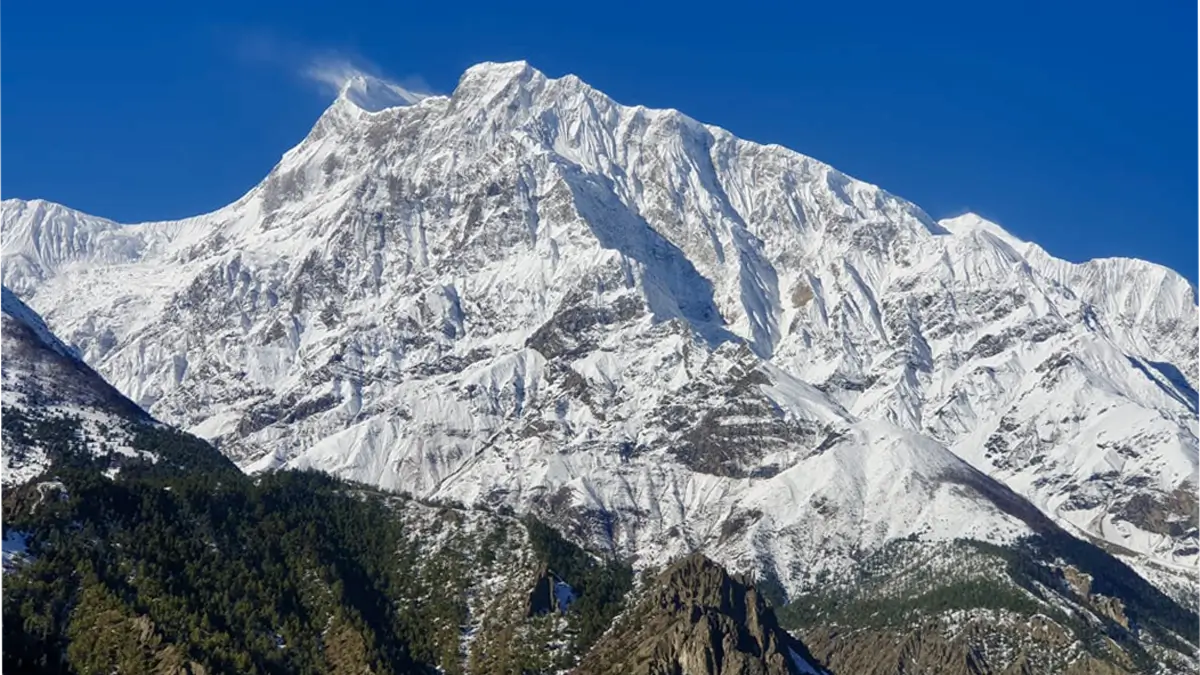
Timing like when planning a trip to the Himalayas, deciding whether visiting them will change the perception of an amazing experience or challenging trek through the rough weather.
Happily, the timing isn’t that important with the Annapurna Circuit – you can trek there pretty much all the time of the year. However, every season has its own feel, highlights, and challenges.
Trekking in Spring, technically known as the time between March and May, will make you feel how the trails are truly alive.
Bright rhododendron flowers, super green valleys, mild weather, clear sky, and don’t forget the fantastic views of Annapurna, Gangapurna and many more mountains in the Annapurna region that you will see on the way.
If you are a fan of beautiful nature, and enjoy the company of other trekkers, this is your time of the year.
Moving further, Autumn, running from September to November, is the so-called Thorong La Pass peak trekking season. The air is fresh after the monsoon, visibility is almost perfect, and the absence of rain makes all the trails dry and safe.
Also, it is the season when most people strive to climb the pass, so that you will face more crowded tea houses, but of course, a more lively trekking setting as well.
Winter (December to February) is not many people trekking there because of the cold and can be of ice.
It is the season when it gets colder, and the compass may become icy. And on rare occasions, nonetheless, it is a beautiful and very peaceful experience if you are prepared for it. And it is just colder, but trekking tea houses are open and running well.
Monsoon (June to August) is the last season, and this is the time that Nepal experiences the heaviest rain. Although Thorong La Pass is situated in Annapurna's rain shadow, trails at lower elevations can be wet. Trekking in the monsoon offers a more tranquil Himalayan experience, but be sure you can handle the rain.
All in all, while spring and autumn are the seasons to go for, winter and monsoon are just for the adventurous exceptions.
| Seasons |
Pros |
Cons |
| Spring (March - May) |
Rhododendron blooms, moderate weather, dry trails |
HIgher numbers of trekkers |
| Autumn (September - November) |
Clear skies, optimal visibility, dry trail |
Peak season, more trekkers |
| Winter (December - february) |
Solidute, fewer trekkers, unique winter landscape |
Cold temperatures, snow and ice |
| Monsoon (June - August) |
Lush greenery, fewer trekkers, unique flora |
Wet and slippery trails in lower regions, potential trail |
Annapurna Circuit Thorong La Pass Trekking Difficulty and Experience Level
Thorong La Pass Annapurna Circuit Trekking is challenging in nature. Sitting at 5,416 meters / 17,769 feet, the sky high pass is enough to give you headaches, nausea, and makes it hard to breath, if you are not well acclimatized.
A day on the Annapurna Circuit Trek usually lasts for about 5 to 7 hours, as you birdwatch through lush snowcapped glacier valleys, to rocky high alpine moorlands. Hence, you have to dance to the mantra: “trek high, sleep low.”
Trek high, sleep low” means you are climbing upwards during the day, but you descend a little bit at night to sleep. In the same way, you will need to take rest days in route as well in as intermediate villages such as Manang.
And finally, you have to be sort of in shape, for which you will need to be doing cardio, hill walking, and stamina-building workouts ahead of time.
Tips for Trekking Thorong La Pass in The Annapurna Circuit
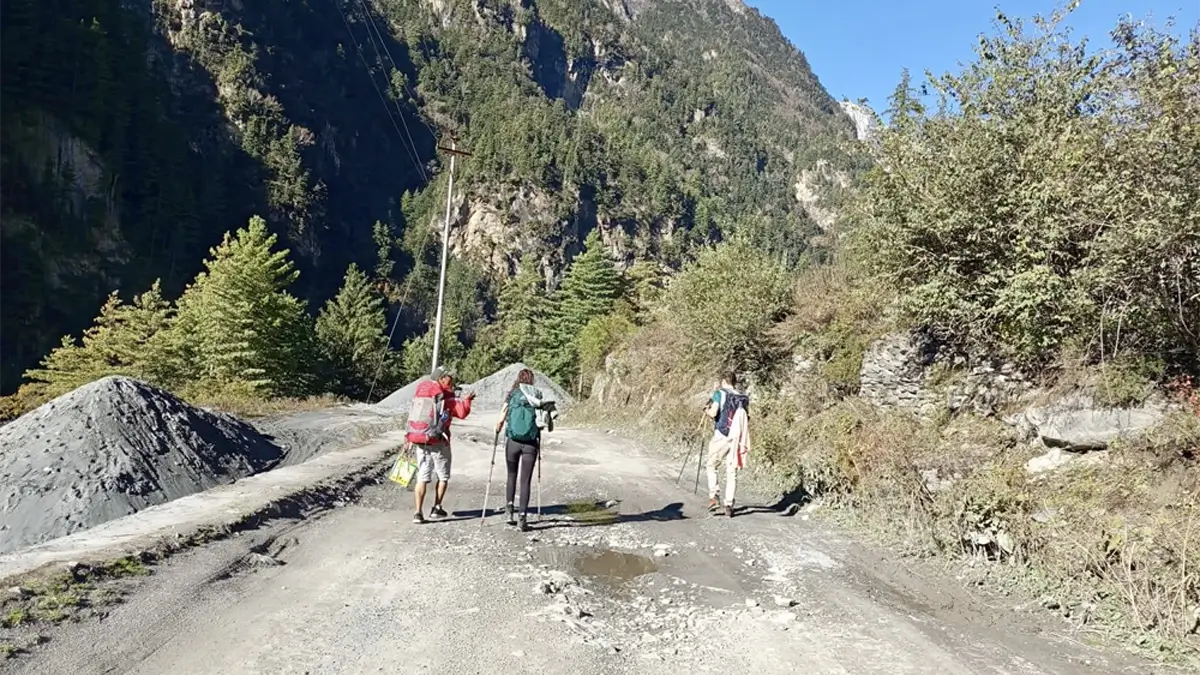
- Maintain a slow and steady pace to conserve energy and reduce the risk of altitude sickness.
- Stay well-hydrated and consume high-energy foods to maintain stamina throughout the trek.
- Bring appropriate clothing and equipment for varying weather conditions, including cold temperatures at higher elevations.
- Prepare mentally for the challenges of long trekking days and potential altitude discomfort.
- Allow sufficient time for your body to acclimatize to high altitudes, even if you are an experienced trekker.
- Stay informed about unpredictable weather patterns in the Annapurna region and plan accordingly.
Cultural Experiences During Thorong La Pass Annapurna Circuit Trek
One of the factors which contributes to making the Annapurna Circuit Trek via Thorong La Pass unforgettably special is the mixture of human culture and traditions along the route.
The Circuit passes through the heartland of different ethnic groups, such as the Gurung, Magar, Manangi, and Thakali. You will see beautiful stone houses, mani walls, and colourful prayer flags waving in the wind.
If your dates are good, you can even get to witness local festivals as Tamu Lhosar (the Gurung New Year) or Maghe Sakranti. And there are dreaded optional side trips like Ice Lake and Tilicho Lake if you want to go beyond the standard trek.
Here, one of the highest lakes in the world, Tilicho Lake, lies at 4,919 meters, people do Annapurna Circuit with Tilicho Lake Trek which makes this quiet detour worth it, with its breathtaking reflections of snow-capped mountain peaks surrounded by nature to the extreme. The shortest trek to Ice lake, also boasts some incredible scenery.
Finally, you will also visit Muktinath, which is a holy place for Hindus and Buddhists. Also, you will discover a combination of prayer wheels, temples, and natural wells.
Annapurna Thorong La Pass Cost Breakdown
The Annapurna Thorong La Pass trek typically costs between USD 1,200 to 2,300, covering essentials like permits, accommodation, meals, and guide services.
Required Permits for Thorong La Pass Annapurna Circuit Trekking
Before you strap on your boots for the Thorong La Pass in the Annapurna Circuit Trek, you must have permits. The permits allow you to venture out in the Annapurna Conservation Area on safe and responsible grounds.
For the Annapurna Circuit trekking, you will need trekking permits:
- Annapurna Conservation Area Permit (ACAP): This is your pass to enter the Annapurna region. It costs around USD 25 - 40.
- Trekkers’ Information Management System (TIMS) Card: It is also required but TIMS CARD just sometimes required for the trek to Annapurna circuit. and this card costs about USD 25 - 40.
Obtaining these permits is easy. They can be purchased via local Nepalese trekking agencies or at official offices in Kathmandu and Pokhara, and sometimes at major trailheads. For the permits, bring your passport (And to enter Nepal must be minimum your passport valid for six months), And passport-sized photos will be great to make trekking permit.
Daily Expenses During Annapurna Circuit Thorong La Trek
What is the actual daily cost on the Annapurna Circuit Thorong La Pass trek? The good news is that even with the million-dollar view of the Himalayas, it’s a lot less expensive than you might think.
Lodging along the trail is normally USD 3 to 33 per day, depending on how much comfort you want. Hot showers, private rooms, and even Wifi are available in low villages as Manang or Chame.
And everything like hot shower, wifi, battery charge you have to pay small amount like 3-5 USD. But at higher elevations, such as Thorong Phedi or High Camp, you will find a more rudimentary set up.
You will pay about USD 4 to 17 for one meal, depending on what you’re going to eat, like breakfast, lunch, and dinner. Here, the Dal Bhat power 24-hour workshop routine can be yours. Dal Bhat is a Nepali traditional food it’s like a combo set meal. It is a satisfying serving of rice, lentils, and veggies that fuels your body for hours. And as you go up in altitude, the costs of food go up, too.
Then there are little additional costs, for hot shower, charging up your gear, Wi-Fi, snacks such as a Snickers bar. Those incidental expenses can run you about USD 5 to 10 a day, depending on your habits. And there will be small expenses also like tea coffee etc.
It’s depending on the services but normally full of trip cost between 1200 USD to 2300 USD. On the Annapurna Circuit Thorong La Pass Trek.
Hiring Guide and Porter Fees for Annapurna Thorong La Pass Trek
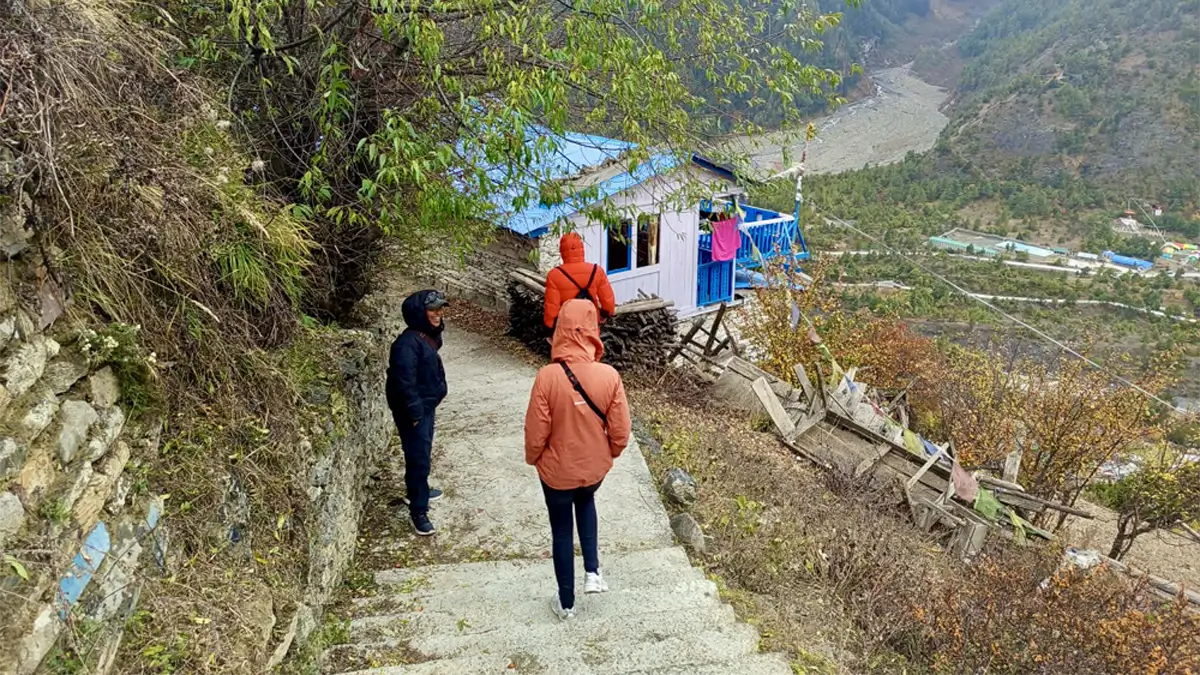
If you are asking me if it is worth hiring a guide or porter for the Annapurna Circuit Thorong La Pass trek, then the answer is absolutely yes.
A government-licensed trekking guide usually costs from USD 30 to 75 per day, which is inclusive of their meals, wages, and accommodation. They will assist you with trails, local culture, weather, and even offer you the morale boosts needed when the altitude gets difficult. They will also assist with logistics, permits, and lodging.
Now, porters' fees vary depending on the distance travelled and the amount of weight, but are generally around USD 23 to 35 per day. A porter can carry up to 18-20 kilograms, so you can trek light. It is also one of the best and most direct ways to help the local community.
So, what do you have to tip? For standard, you will have to minimum10 to 15% of the total amount of the trip after the trek, you can give also more dependent on service and length.
Additional Costs for Annapurna Circuit Thorong La Pass Trek
There are a few extra expenses you need to consider when you are planning your Annapurna Circuit Thorong La Pass trek, apart from your accommodation and food.
You have to buy travel insurance that covers trekking at altitudes of 5,500 meters first of all. Because you’re going to the highest elevation of this trek is 5,416m, Thorong La Pass. The plan should provide coverage for altitude sickness, emergency evacuation, helicopter rescue etc.
Pro tip: Buy your trekking insurance before you come to Nepal. And make sure it is coverage for all needed expenses.
Additionally, you also need to pay up for the rental gear on top of that, if you don’t plan on buying the pricey stuff.
You can rent sleeping bags, down jackets, and other gear in Kathmandu or Pokhara at around USD 5 to 15 a day. But it is good to buy in the home country, where the quality is better.
And finally, don’t forget the transportation! It costs about USD 10 to 30 to get to the trailhead, Besisahar, from Kathmandu, depending on whether you are taking a local bus that’s good quality
And hiring a private jeep. After the trek, the journey from Muktinath to Jomsom to Pokhara or Kathmandu costs another USD 40 to 90. Different costs with different transportation, like sharing a bus, a private jeep, a shared jeep, etc.
Packing Gear List for Thorong La Pass Annapurna Circuit Trekking
Clothing:
- Waterproof trekking jacket (windproof and insulated)
- Down or synthetic insulated jacket for cold nights
- Fleece or mid-layer jacket
- Moisture-wicking base layers (tops and bottoms)
- Trekking pants (lightweight and quick-dry)
- Thermal underwear
- Shorts
- Gloves (light and insulated)
- Warm hat or beanie for cold nights
- Neck gaiter or buff
- Sunglasses (UV protection)
Footwear:
- Trekking socks (wool or synthetic, multiple pairs)
- High-quality trekking boots (waterproof, broken-in)
- Camp shoes or sandals
Gear & Accessories:
- Trekking backpack (35 to 50 L)
- Daypack
- Sleeping bag (rated to -10°C or lower)
- Trekking poles
- Water bottles or hydration bladder
- Water purification tablets or filter
- Headlamp or flashlight (with extra batteries)
- Lightweight travel towel
- Snacks (energy bars, nuts, chocolate)
Personal Items:
- Personal first-aid kit (blisters, painkillers, altitude sickness meds)
- Sunscreen (high SPF)
- Lip balm with SPF
- Toiletries (toothbrush, toothpaste, biodegradable soap, quick-dry towel)
- Hand sanitizer / wet wipes
- Camera or smartphone
- Power bank or solar charger
For more trekking gear and item list click here
Conclusion
The Thorong La Pass Annapurna Circuit Trekking starts off with a pine scent from the green hills. You will enter gorges, dungeons, and valleys in a subtropical climate around Besisahar and proceed to windswept, cold high altitude deserts on the opposite side of the valley Manang to Muktinath Temple.
As you trek across suspension bridges over raging rivers, drink tea with locals in warm tea homes, and eventually reach Thorong La Pass (5,416 meters) at the highest point.
While preparing yourself for the Annapurna Circuit and Thorong La Pass Trek, you ought to take some time to prepare yourself, respect nature, and accept the bare simplicity of mountain life. And if that’s still not enough adventure, detours to places like Tilicho Lake or Ice Lake.
FAQs
Is it a hard trek to the Annapurna Circuit Thorong La Pass?
The trail is fairly strenuous, owing to the altitude at Thorong La Pass (5,416 meters).
How many days is the Annapurna Circuit trek with Thorong La Pass crossing?
You should allow about 10 to 16 days to complete the circuit with the Thorong La pass top, including acclimatization days and rest days.
How can I safely pass Thorong La Pass?
You need to start early, acclimatize well, keep an eye on the weather, and hire a guide for your safety, security, and easy access.
What is the price of the Annapurna Circuit Thorong La trek?
The prices vary between USD 1,200 and 2,300 depending on the service provide in package trip.
When is the best time for trekking in Thorong La Pass in Annapurna Nepal?
Trekking available all year, and recommended season is Spring (March to May) and Autumn (September to November) provide the best clear sky with mild weather. (but weather can be change any time in the Himalayas)
Why Thorong La Pass Annapurna Circuit Trekking is so popular?
For breathtaking Himalayan views, changing landscapes, fascinating cultural experiences, and the excitement of crossing one of the highest trekking passes, Annapurna Circuit is hard to beat.
Can I trek Thorong La Pass by myself, or do I have to join a group?
It is your choice and what you like, like joining a group or doing solo, private trek but it is good to join the local trekking agency and travel with a local guide.
No, you can’t go to Thorong La Pass solo; thus, you will need to travel with a guide or group.
What are the optional side excursions during the trek?
Side trips to Ice Lake or Tilicho Lake are common for scenic views and further Annapurna trekking adventure.
Should I get trekking insurance for Annapurna Circuit Thorong La Pass?
Yes, special trekking insurance for high altitude trekking with coverage for emergency airlift is highly recommended. The elevations have to covered 5,500m.







